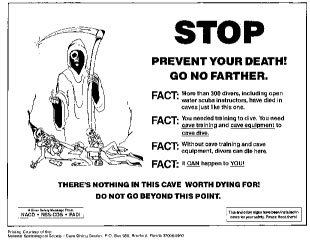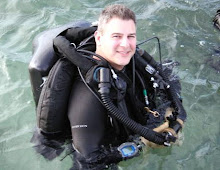Cave Diving in Florida January 2007

It had been a long time, too bloody long since I had been in a cave. Much has happened in my diving since I got my cave cert in December of 2004, most notably that I have given up open circuit for closed circuit diving. "What will it be like on a rebreather?" I wondered, as Ted McCoy, Greg Jackson and I chugged south on 95 in Ted's hunkin' chunkin' diesel pickup, loaded with everything from five rebreathers to untold stages to a booster, a scooter, my favorite cooking pot, and a big ole sack of Long Island potatoes. Think the Beverly Hillbillies, minus Grandma in her rocker. The plan was for the three of us to drive down a day early. Carl Bayer, Sunny Longordo and Gabe Lamarre were to join us later for a ccr cave course/normoxic trimix class with Martin Robeson, who was flying in from the
The drive down wasn't bad, 17 hours from
The very first cave I looked into was Telford Spring, back in '03. I had to wait at the mouth of it while some friends did a dive, as my class didn't start until the next day. What an incredible tease back then to see Adam and Ed tie off and disappear inside. Ted had to drive down to
Cow Spring Upstream was a very serious dive, one I probably shouldn't have been on. Let's just say there was a bit of a fudge factor on the requirements and leave it at that. Greg's black cloud made an appearance minutes before the dive, when his light failed him, but on the up side he got to go watch football. The entrance was about as tight as anything I will fit into, at least with the Prism. There are several switchbacks that involve full-on cramming yourself into a restriction, bailout removed, shallow breaths, face in the sand, in the dark, wiggling and scrabbling to find purchase to ease in a half inch at a time. Wow was that tight, but so worth it. The tunnels have these beautiful scalloped walls, then gorgeous open chambers. Part of why the cave is restricted is due to its delicate nature, so we were on our best behavior to be precise with our buoyancy and not touch anything. Towards that end they have a large rope tied off parallel to the mainline, to help through the higher flow areas. With care though we were able to not use that either, as it still unavoidably abrades the rock. About halfway back is a tight crack in the floor, snug but doable, that leads down below 100' to a more open, mazelike area. We turned with regrets at 1700' when it narrowed down to sidemount-only, hitting a jump on the return. I was not too excited at the prospect of doing an open circuit bailout, what with all those restrictions, but our rebreathers justified our faith in them and performed flawlessly. Later that day Ted and I did a reprise of Telford Spring, pushing much farther than Greg and I had the previous day. It is very obvious where the open circuit divers hit their thirds about 2000' back, as the cave gets dramatically darker and much siltier all of a sudden. No more limestone rubbed white, no handprints in the mud, just clear water and dark surfaces that sucked the light right out of our HIDs.
With Greg's light back online we headed over to Little River the next day. The flow was relatively low compared to how it sometimes blows there, but even so it took some doing. The spring heel on Ted's fin came loose but was field-repairable, so we continued on. We made a long loop through varied terrain, including a few jumps. Back a couple of thousand feet is a test well drilled through the ceiling, which was very strange to come across. Shortly thereafter we went over a rise, down a rise, then turned the dive as the passage got too narrow for back-mount. It was there that I had a reminder how quickly things can turn in a cave, as a couple of blips in the mud reduced visibility to zero. I grabbed onto the line, further reducing visibility as it was touching the silt, strained to see my buddies lights in the brown out, and kicked towards the exit and clear water. There was never any danger, but it got me to thinking how quickly a silt out can lead to a lost line, lost buddy emergency. It was a valuable lesson. On the drive back from Little River a wild boar crossed our path. It was enormous! Much bigger than any black bear I've seen, and I see those all the time. I have a new-found respect for the guy I met once who hunts them with a spear.
That night the lot of us packed our stuff and headed west to Marianna. Ted had rented a house there, pics of which can be seen at holeinthewallhouse.com. Billy Gambrel and Bill Graham, two
Our first day there Ted, Greg and I cruised (well, chugged) down to Jackson Blue. What an amazing cave, starting with a gorgeous cavern zone. The cave slopes down gently until about 200' back, then drops off a cliff from 30' down to 70'. Its all fairly open, wide and pretty. The first 2000' are perfect for scooters. Ah, next time. We turned the dive at about 2200' back, then sailed in the flow for a much faster exit. Greg's drysuit was compromised, plus he wasn't wearing a hood, so he froze his nethers off the entire dive. Credit where credits due though, he kept his head in the game and his skills sharp, which is not always easy when you are physically miserable. Our deco time was spent playing with the blue, black and yellow crayfish in the cavern, some of which are just enormous. It helped scratch my urge to be catching lobsters.
Greg, Ted and I returned the next day to Jackson Blue, but Greg aborted on the surface when his drysuit again flooded. Ted and I shadowed the class with our lights off, resisting the urge to grab the hindmost just to hear him squeak. This wound up being my favorite dive of the trip so far. Ted led, and at a very sensible pace. Too often I have the open-circuit mentality that I need to hurry up, so I can get as far as possible before turning on thirds. It was a real pleasure to just take our time in the cave, exploring different loops and enjoying the scenery. Ted had brought an extra bailout bottle, so we dropped that at our point of deepest penetration yesterday and kept on going. Around 3000' there was a crazy spiral pattern in the floor, which we later found out was due to a scooter with a jammed open trigger, leading the diver to slam it into the mud and then up against a wall until the battery died. It must have been quite a sight, or not considering how much silt would have been kicked up. At an hour and 45 minutes we turned the dive, 3700' into the cave.
Despite hearing that
That night Ted Green and Mark Nix came down from
Saturday was the day we picked for the Journey to the Center of the Earth dive. The gold line runs a mile back into Jackson Blue, and we were determined to run it out to the very end, then check out some chambers off of it. Including staged bottles we had five aluminum 80's to get us out, plus an al40 of O2, and another of 70%. More than enough bailout. It was a long swim, but after a little more than two hours we hit the end of the mainline at 4450', which terminates with a taunt ("stroke!"). An exploration line continued a few hundred more feet back towards the source of the spring. Right near the end was a chamber called the Stratosphere. What an amazing place. The ceiling shot up 70' to a beautiful pure white dome, and the walls were terraced like an opera house. It's like nothing I've ever seen.
The way out got interesting. Greg was leading for the exit, and was apparently ready to get out. Ted and I were still enjoying the Stratosphere when he dropped down under a ledge and disappeared. We went after him, but he had left the gold line, taken another turn, and shot down a narrow silty tunnel. After a heated pow-wow Ted took off after him while I stayed back at the crossroads. A long ten minutes later they returned through a cloud of silt, and we reformed our group and exited without incident. Its not really the kind of thing you want to deal with 4200' back, but I guess the important thing is to be able to deal with it. My love for the RGBM algorithm was renewed when we got back to the mouth, and I found I had 18 minutes of deco compared to the hammerhead's 80 minutes. Our overall runtime was five hours, by far the longest dive I've done to date.
For this trip we had a number of rebreathers with us. There was my Prism, Greg's HammerMeg, Ted McCoy's HammerMeg, Gabe's stock Meg, Carl, Sunny, Ted Green and Martin on Classic Kisses, and Mark on his FrankenVisionInspiration (or was that FrankenHammerInspiration?). Billy Gambrel later showed up with his incredibly cool sidemount Prism, a very polished mod indeed, and did several dives with Tobias on his Inspiration. In addition Ted McCoy had Ron Benson's old Optima, which he dove for several days and enjoyed thoroughly. All these rebreathers gave me the opportunity to try something new, and for the last two days I played around on a HammerMeg. I really liked how it was weighted and balanced, and the Hammerhead heads-up display, with its PO2 monitor, was way cool. The unit was set to use the Juergensen algorithm for adding O2, which held an impressively solid setpoint. No matter how much up and down I did, within 30 seconds it had the setpoint nailed down tight. I liked it. I liked it a lot. The profile was much lower than my Prism, which helped when Ted and I were determined to force a passage in Jackson Blue. We eventually dug a channel through the sand and wiggled in, laughing like fools. For my last dive we went back to Hole in the Wall, and did several dark and silty jumps. The restrictions and switchbacks make it impossible not to silt out, and the low flow means it doesn't go anywhere for days. So, my apologies to anyone who followed us, but we had ourselves some fun.
When we returned to the dock we found Carl and Sunny looking bedraggled but proud, having successfully completed both their cave and trimix certs. Congratulations to them, and congratulations to me too, because more ccr-cave dive buddies = more cave diving for Rob = happy Rob.




